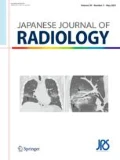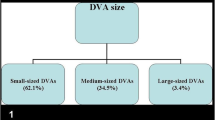Abstract
Purpose
To evaluate brain parenchymal high-signal-intensity abnormalities within the drainage territory of developmental venous anomalies (DVAs) identified by susceptibility-weighted imaging (SWI) at 3 T.
Methods
One hundred and thirty patients with 137 DVAs identified by SWI were retrospectively studied. 3D fluid-attenuated inversion recovery (FLAIR) images were reviewed for parenchymal high-signal-intensity abnormalities and SWI images were reviewed for hypointense foci (microhemorrhages or cavernous malformations) adjacent to DVAs. Patient age, the degree of underlying white matter disease, DVA location (supratentorial or infratentorial), and the presence or absence of hypointense foci were compared across DVAs with and without high-signal-intensity abnormalities. The correlation between patient age and the size of any high-signal-intensity abnormality was analyzed using linear regression.
Results
Forty-two of 137 DVAs (30.7 %) had high-signal-intensity abnormalities. An adjusted prevalence of 18/71 (25.4 %) was obtained after excluding patients with considerable underlying white matter disease. Only DVA location (supratentorial) was associated with the presence of high-signal-intensity abnormalities (p < 0.05). There was a significant correlation between patient age and the size of high-signal-intensity abnormalities (p < 0.01).
Conclusions
3D FLAIR imaging permits detection of small high-signal-intensity abnormalities within the drainage territory of DVAs. The size of high-signal-intensity abnormalities increased with patient age.



Similar content being viewed by others
References
Wilms G, Bleus E, Demaerel P, Marchal G, Plets C, Goffin J, et al. Simultaneous occurrence of developmental venous anomalies and cavernous angiomas. AJNR Am J Neuroradiol. 1994;15:1247–54.
Huber G, Henkes H, Hermes M, Felber S, Terstegge K, Piepgras U. Regional association of developmental venous anomalies with angiographically occult vascular malformations. Eur Radiol. 1996;6:30–7.
Abe T, Singer RJ, Marks MP, Norbash AM, Crowley RS, Steinberg GK. Coexistence of occult vascular malformations and developmental venous anomalies in the central nervous system: MR evaluation. AJNR Am J Neuroradiol. 1998;19:51–7.
Lasjaunias P, Burrows P, Planet C. Developmental venous anomalies (DVA): the so-called venous angioma. Neurosurg Rev. 1986;9:233–42.
Okudera T, Huang YP, Fukusumi A, Nakamura Y, Hatazawa J, Uemura K. Micro-angiographical studies of the medullary venous system of the cerebral hemisphere. Neuropathology. 1999;19:93–111.
San Millán Ruíz D, Delavelle J, Yilmaz H, Gailloud P, Piovan E, Bertramello A. Parenchymal abnormalities associated with developmental venous anomalies. Neuroradiology. 2007;49:987–95.
Takasugi M, Fujii S, Shinohara Y, Kaminou T, Watanabe T, Ogawa T. Parenchymal hypointense foci associated with developmental venous anomalies: evaluation by phase-sensitive MR imaging at 3T. AJNR Am J Neuroradiol. 2013;34:1940–4.
Santucci GM, Leach JL, Ying J, Leach SD, Tomsick TA. Brain parenchymal signal abnormalities associated with developmental venous anomalies: detailed MR imaging assessment. AJNR Am J Neuroradiol. 2008;29:1317–23.
Reichenbach JR, Jonetz-Mentzel L, Fitzek C, Haacke EM, Kido DK, Lee BC, et al. High-resolution blood oxygen-level dependent MR venography (HRBV): a new technique. Neuroradiology. 2001;43:364–9.
Kitajima M, Hirai T, Shigematsu Y, Uetani H, Iwashita K, Morita K, et al. Comparison of 3D FLAIR, 2D FLAIR, and 2D T2-weighted MR imaging of brain stem anatomy. AJNR Am J Neuroradiol. 2012;33:922–7.
Kallmes DF, Hui FK, Mugler JP 3rd. Suppression of cerebrospinal fluid and blood flow artifacts in FLAIR MR imaging with a single-slab three-dimensional pulse sequence: initial experience. Radiology. 2001;221:251–5.
Thomas B, Somasundaram S, Thamburaj K, Kesavadas C, Gupta AK, Bodhey NK, et al. Clinical applications of susceptibility weighted MR imaging of the brain––a pictorial review. Neuroradiology. 2008;50:105–16.
Kakeda S, Korogi Y, Hiai Y, Ohnari N, Sato T, Hirai T. Pitfalls of 3D FLAIR brain imaging: a prospective comparison with 2D FLAIR. Acad Radiol. 2012;19:1225–32.
Noran HH. Intracranial vascular tumors and malformations. Arch Pathol Lab Med. 1945;39:393–416.
Hachinski VC, Potter P, Merskey H. Leuko-araiosis: an ancient term for a new problem. Can J Neurol Sci. 1986;13:533–4.
Hachinski VC, Potter P, Merskey H. Leuko-araiosis. Arch Neurol. 1987;44:21–3.
Munoz DG, Hastak SM, Harper B, Lee D, Hachinski VC. Pathologic correlates of increased signals of the centrum ovale on magnetic resonance imaging. Arch Neurol. 1993;50:492–7.
Moody DM, Brown WR, Challa VR, Anderson RL. Periventricular venous collagenosis: association with leukoaraiosis. Radiology. 1995;194:469–76.
Brown WR, Moody DM, Challa VR, Thore CR, Anstrom JA. Venous collagenosis and arteriolar tortuosity in leukoaraiosis. J Neurol Sci. 2002;15:159–63.
Töpper R, Jürgens E, Reul J, Thron A. Clinical significance of intracranial developmental venous anomalies. J Neurol Neurosurg Psychiatry. 1999;67:234–8.
Conflict of interest
Maki Umino: the authors declare that they have no conflict of interest.
Author information
Authors and Affiliations
Corresponding author
About this article
Cite this article
Umino, M., Maeda, M., Matsushima, N. et al. High-signal-intensity abnormalities evaluated by 3D fluid-attenuated inversion recovery imaging within the drainage territory of developmental venous anomalies identified by susceptibility-weighted imaging at 3 T. Jpn J Radiol 32, 397–404 (2014). https://doi.org/10.1007/s11604-014-0322-0
Received:
Accepted:
Published:
Issue Date:
DOI: https://doi.org/10.1007/s11604-014-0322-0




